This page shows the second half of Italy's regional patterns.
Romagnole
Location: Romagna
No.of cards: 40
This pattern belongs to the central-southern group, and is basically
halfway between the Piacentine and the Napoletane,
probably sharing a common origin with the former cards, but the
illustrations appear less refined, and court cards are single-ended,
as in the latter pattern.
The aces of this deck are a curious mixture of styles: the one of Coins is almost a blank
card, resembling the ones belonging to northern patterns; the aces of Cups and Swords recall
the ones found in the above-mentioned Piacentine, while the one of Batons resembles
the Spanish Catalan style (see Spanish gallery), featuring a
rough cudgel with branches along the shaft. |
 |
Salzburger (or Salisburghesi)
Location: south Tirol (the northern-eastern borders)
No.of cards: 40 (formerly 36)
A peculiar pattern is the one used by the German-speaking people of south Tirol.
It is indeed closer to a German deck than to an Italian one, with the typical
suit system featuring Hearts, Acorns, Leaves and Bells, no aces (deuces act
as aces in German decks), and a Weli card acting as a joker, typical of Austrian patterns (see the relevant gallery). Also the name of
the deck refers to the Austrian city of Salzburg; in fact, the same pattern is also produced in Austria, where it is known both as Salzburger and as Einfachdeutsch (more or less "single-ended German"), to distinguish it from
the German Bayerisches Bild ("Bavarian pattern"), very similar but whose design has long since become double-ended. |
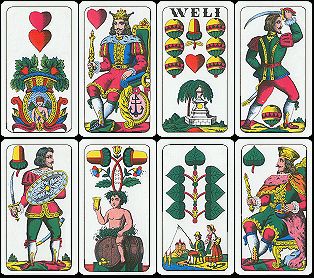 |
All the subjects are very richly decorated, with brilliant colours and small
decorative views and naive figurines at the base of the pip cards.
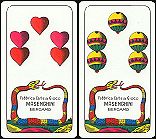 |
Curiously, the original number of cards in this deck used to be 36 (as it still is in Austrian-made editions), but during the 1980s Italian manufacturers raised
the number of cards to 40. So also 5s were added to each suit, all of them featuring the same multicoloured serpent as a decoration. It is not clear whether the reason of this change was simply to conform the deck to the number of cards of most other Italian patterns, for the sake of an easier cutting and packaging process.
|
A visitor of this website, Domenico Starna, suggested that the Salzburger deck with 5s added may be used for playing Tresette, after having witnessed locals doing so somewhere along the Italian side of the Tirolian region. Actually, this game can be played with a 40-card deck, regardless of the different values of the pip cards, i.e. 1 to 7 if using Italian suits, 2 (daus, used as an ace) and 5 to 10 with German suited decks. However, in the same area the Trentine pattern, with northern Italian suits (see below), is also popular, and probably even more suitable for playing Tresette, although German-speaking native players understandably prefer the Salzburger pattern all the same, because of its suits.
Sarde
Location: Sardinia
No.of cards: 40
More than an Italian pattern, the Sardinian pack could be described as an old-looking
Baraja Española, Spanish national pattern (for a visual comparison, see the
Spanish gallery). The many similarities between the
two styles, and the strong cultural links between Sardinia and Spain (especially the
island's western coast), leave no doubt about the origin of the Sarde cards. |
 |
As the Spanish ones, also the Sarde have tiny numeric indices in the corners. Furthermore, despite
being a 40-card pack, the Sardinian courts are indexed 10 (knave),
11 (cavalier) and 12 (king), in the same way as Spanish ones.
A further element of similarity with the Baraja Española is the ace of Coins:
unlike any other Italian pattern, it features a big yellow coin, quite reminiscent
of the medal featured in Spanish decks, although no further decorations (flags, crests,
etc.) appear in the Sarde's card.
Siciliane
Location: Sicily (and southern areas)
No.of cards: 40 |
 |
The Sicilian pattern shows relations with the Napoletane; as the latter, it was
probably born in the 19th century (clothes and hair style account for this
dating), and many cards have pips arranged in a similar way. Also the size of the deck
is similar, smaller than the average. These ones, though, look even more naive; they often
feature small decorative figurines to fill the blank spaces, while suit signs are rather
simple. |
 |
In the 5 of Coins the central pip, larger than the others, features a two-horse chariot driven by a female figure (an allegory of Italy): it comes from a 10 Lire coin issued in 1926; previously, in place of this picture a head of the national hero Giuseppe Garibaldi appeared on the card, in memory of his landing in Sicily with his legendary thousand volunteers in 1860. An edition by manufacturer Azzarello (1930s) is also known, in which the hero is featured in place of the usual cavalier of Batons, with the famous words addressed to officer Bixio: Nino, domani a Palermo ("Nino, tomorrow in Palermo").
The pattern is not confined within the Sicilian island's boundaries: in some southern
regions of Italy, many players prefer to use the Siciliane cards rather than the Napoletane ones. |
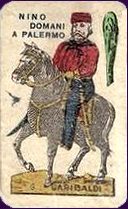 |
Toscane and Fiorentine
Location: Tuscany
No.of cards: 40
The Tuscan patterns are among the most beautiful regional cards: their
single-ended courts (all other French-suited patterns are double-ended) feature
characters in colourful Renaissance-style clothing, and have a very attractive look.
Presently, the Toscane and the Fiorentine - the latter name specifically refers to the city of Florence - feature the same illustrations, the only
difference being the size of the two decks:
|
 |
 |
- Toscane : 5.6 x 8.8 cm (2 1/4 x 3 1/2 in);
- Fiorentine : 6.7 x 10 cm (2 5/8 x 4 in).
The Florentine pattern is manufactured by Modiano under the name Toscane Grandi ("Large Toscane").
Being larger, the Fiorentine cards printed by the aforesaid manufacturer have more accurate and sharper details: on books, parchments, etc. held by court characters, the firm's name often appears in small lettering, perfectly readable, whereas in the Toscane pattern this is impossible due to the tinier size of the details. Instead Fiorentine editions printed by other manufacturers (Dal Negro, Masenghini) feature the same design as the Toscane, without any noticeable difference except the size of the cards. |
Up to 30-40 years ago, the Toscane mismatched the present pattern. In particular, the attitude of the personages was rather different: the picture on the right shows a comparison between the Fiorentine (above), now sharing their design with the modern Toscane, and the obsolete Toscane (below, from an edition by Viassone). |
 |
The old version of the
Toscane pattern was discontinued around the mid 20th century; it was replaced by the same design used for the
Fiorentine, printed on slightly smaller cards.
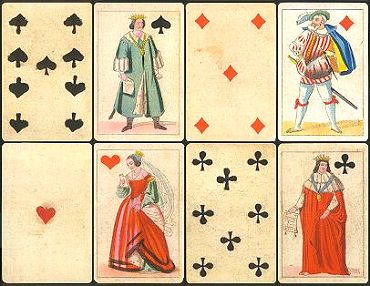 |
The sample on the left, instead, comes from a replica of a Toscane edition dating back to 1850, printed by the obsolete manufacturer Chiari. It represents a further early variant of the Florentine pattern, whose design was probably unique to the aforesaid maker. In this particular deck the 8s, 9s and 10s were drawn by hand and added to the standard cards, turning the regional pattern into a 52-card deck with a wider range of use. |
Trentine
|
Location: Trento (and surrounding areas)
No.of cards: 40 - 52
Typical northern pattern, rough and naive, it exists in both 40-card
and 52-card editions, although only few manufacturers produce the latter.
Its size is considerably wider than the other northern patterns to which it relates (Bresciane, Bergamasche).
The Trentine can be easily told by their single-ended courts; all
four kings are seated, and the one of Coins sits on the blank space for
the tax stamp: unlike other patterns in Italy, the stamp was not placed on the
ace of Coins, which instead features a decorated oval or medal with a human figure. |
 |
Several cards feature numerals for an easier reading of the value, though they are not
located in the corners as the indices of a Poker deck.
Another curious feature is the multicoloured hair of the court characters.
Trevigiane (or Trevisane, or Venete)
Location: Treviso (and Veneto region)
No.of cards: 40 - 52
This pattern is properly known as Trevigiane or Trevisane, since it originally comes from the city of Treviso; this is confirmed by the city's seal, often featured by the king of
Batons, with the Latin name Tarvisium (see detail below); some manufacturers,
though, prefer to call these cards Venete, because they are commonly used in the whole
Veneto region.
The Trevigiane pattern maintained a rather classic northern look,
accurately decorated, almost similar to the set of suit cards in a tarot deck. It is available in both the 52-card edition (probably the original one) and the 40-card one, without the 8s, 9s and 10s.
Among the suit signs, Coins are the ones that can be easily told by their typical half blue and half yellow colour.
|
 |
 |
Another well-known feature is that three
aces out of four bear a motto or a proverb (see the Expressions gallery
for their text), while another very distinctive detail is that the knave of Swords always
holds in his left hand a severed head.
In several editions, the Trevigiane deck also has a typical back pattern (shown on the right):
a female figure with a spear and a shield, standing by a broken column. This
character is quite reminiscent of the allegorical representation of Fortitude
in classic tarots, which this pattern is surely related to. |
 |
Triestine
Location: Trieste
No.of cards: 40
Together with the Bergamasche, this northern pattern is now only available in the 40-card version. Its style is reminiscent of the Trevigiane, likely representing an evolution of the aforesaid pattern in the furthermost north-eastern corner of Italy. Also in this case the
aces feature mottos, in all four suits (though they are different from the ones found in the Trevigiane, see Expressions gallery).
The court characters are rather stylized, and their wide base recalls
the "Large Crown" pattern (see Austrian gallery), which up to the
first half of the 20th century was indeed popular in this area. |
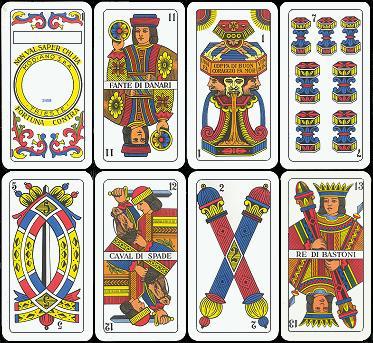 |
The distinctive feature of the Triestine is the name of each court, spelled in full on the white rectangular space that doubles the illustration, a detail only found in tarot decks, although
usually located at the base of the subject. This rectangle did not exist in editions prior to c.1900.
All the subjects have small numbers, which act as indices, but only in court cards they are located in the corners. Having sprung from the Trevigiane, which originally was a 52-card deck, also the courts of the Triestine are numbered 11 (knave), 12 (cavalier) and 13 (king). Due to this, now a gap seems to exist
between the last pip card, i.e. 7, and the following knave (11); a similar situation is also that of the Sarde deck, as well as of any Spanish-suited pattern in 40-card edition.
page 1
regional patterns - part I |
page 2
regional patterns - part II |
page 3
regional patterns - part IV |
page 5
fancy patterns |
OTHER GALLERIES






















or back to

INTRODUCTION
AND HISTORY
|

MULTI-LANGUAGE
GLOSSARY |

THE FOOL &
THE JOKER |

INDEX
TABLE |

REGIONAL
GAMES |

PLAYING CARD
LINKS |